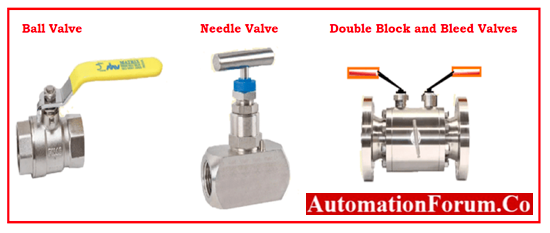
What is an Isolation valve?
- Isolation valves are mounted on process lines and are used to isolate pressure gauges, pressure transmitters, orifice plate pressure tappings and other measurement instruments.
- Isolation valves are installed in the drain or vent lines of pressure measuring instruments and are activated when the contents must be drained or vented before beginning any maintenance work.
Purpose of Isolation valve
- The isolation valve is used to facilitate the removal of maintenance instruments mounted on process media pipelines such as liquids, gas, or steam.
- An isolation valve in a process operation can help to stop and divert process media to another location. It is useful in shutting down process plants when vent lines or drain lines are present.
- These valves remain open during regular operation. They are closed under special circumstances, such as for safety reasons or system maintenance or repair.
- Isolating valves are also commonly used at the blank end of lines or manifolds to allow for the future connection of additional equipment without interrupting operating processes.
- Isolation valves are a crucial component of any fluid system, as they are used to stop the flow of fluid into a specific system area. They are sometimes used to manually control the fluid’s flow as well.
Rocker Style Isolation Valves

- A rocker isolation valve is operated by the solenoid valve.
- To seal the valve seat and isolate the flow path, this valve employs a rocker mechanism that pivots.
- Rocker isolation valves can be configured as simple Two-way valves or as multi-port selectors.
- In general, rocker isolation valves are smaller and more compact than diaphragm isolation valves.
- Rocker isolation valves are well suited for specific applications with limited space.
- Rocker valves, however, have dead volume and are less well-swept than diaphragm isolation valves, despite their low internal volume.
- Rocker Style Isolation Valves have elastomeric seals, which reduces their lifespan and makes them less chemically compatible than diaphragm-style valves.
- In industry, this type of isolation valve is most commonly used for dispensing materials or driving larger valves.
Advantages of Rocker Isolation Valves
The benefits of rocker-style isolation valves are
- Relatively Inexpensive.
- Low Internal Volume
- Fast Actuation Times.
Diaphragm Isolation Valves
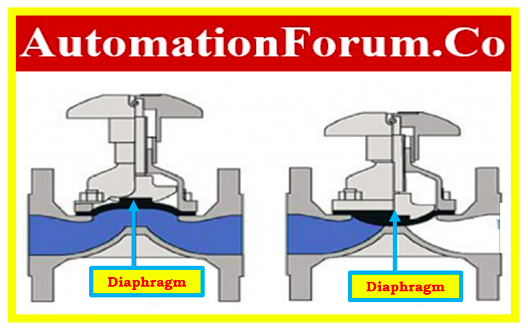
- Diaphragm isolation valves are acclaimed as membrane valves.
- It is a solenoid-operated device that seals the valve seat and isolates the flow path by extending and retracting a diaphragm.
- Diaphragm isolation valves, like rocker-style valves, can be configured as simple on/off 2-way or 3-way devices.
- The diaphragm of a diaphragm isolation valve is made of non-elastomer materials such as PTFE.
- Some isolation valves having diaphragms use an elastomeric membrane like FKM or EPDM.
- Diaphragm isolation valves are made of inert materials and have an entirely inert fluid path.
Advantages of Diaphragm Isolation Valve
- They have a much longer life than rocker-style isolation valves
- Better swept.
- Have significantly less dead volume—some as little as zero.
- The diaphragm eliminates the need for seals.
- Has high chemical compatibility.
- Perfect for corrosive media applications.
What are the factors to be considered in selecting Diaphragm Isolation Valve?
Important factors to consider when choosing a Diaphragm Isolation Valve
- The material of the diaphragm and the media that will be used.
- These material’s high flexibility allows them to tolerate small amounts of fine particles, but common chemicals such as methyl alcohol or ammonia can damage these diaphragm membranes.
- When selecting a valve for use with corrosive media, ensure that all wetted materials are inert. The flow path and all wetted areas of the valve should be constructed of an inert material compatible with the media to ensure the longest lifespan and lowest risk of cross-contamination.
Pinch Valves
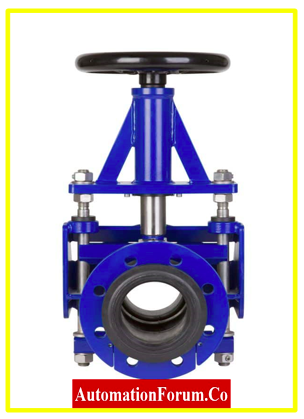
- A pinch valve is a device that allows the flow path to be opened and closed by pinching a removable, disposable tube.
- Pinch valves perform a similar function by isolating the valve mechanism from the media using disposable tubing.
- Pinch valves can be configured as simple on/off 2-way devices with single tubes or as multi-port selectors/diverters with multiple tubes.
- Pinch valves can be operated by electricity, air pressure, or by hand.
- The operating power of electrically actuated pinch valves varies greatly depending on their application and size.
- Most draw between 0.5 and 10 watts AC or DC at a variety of voltages—typically 12 or 24 VDC—and can usually be powered by the internal power supply of a medical system.
- In explosive/hazardous environments where a shorted or overheated solenoid could become an ignition source, pneumatically actuated pinch valves is the preferred choice.
- They can also deliver more force, which makes them an excellent choice for applications that require firmer (higher durometer) tubing. Another advantage is that pneumatically piloted units can be scaled down to fit into smaller, more compact spaces because they can provide more force.
Lifetime Considerations
- The operational lifetime of its components becomes an important design factor.
- Pinch valves are subject to wear and tear as well, but the majority of this occurs in the pinch tube itself, which is designed to be disposable.
- The lifespan of the pinch tube itself varies greatly depending on the material used. Tubing made of neoprene,
- This means that a pinch valve’s operational life is primarily limited by the lifespan of its pneumatic actuator or electrical solenoid, frequently rated in the hundreds of millions or even billions of cycles.
Types of Isolation Valves
- Rotary Movement Valves
- Linear Movement Valves
Rotary Movement Valves

Ball valves and butterfly valves are grouped into the rotary movement valve category. Ball valves have a tight shutoff and a handle that indicates whether the valve is open or closed. Because a sudden opening damages the gauge or diaphragm of the transmitter, the slow operation is required. The design of ball valves allows for easier cleaning and reduces the possibility of clogging.
Linear Movement Valves
Ball valves and needle valves are commonly used to isolate instruments. Instrument needle valves are highly reliable for regulating, throttling, and isolating gaseous, and non-viscous liquids of various types.
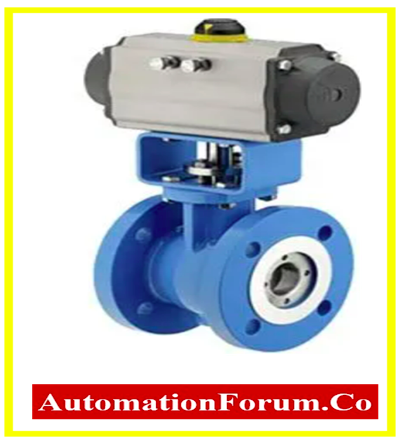
- Needle valves operate on a linear movement. Needle valves can control the flow of liquids or gases, allowing the flow to be gradually reduced and eventually shut off completely.
- Fluids under pressure cause damage due to sudden surges, so needle valves are used to control flow into delicate and sensitive gauges.
- Because the orifice is small, needle valves are typically easy to close completely with finger-tight pressure.
Isolation Valve Configurations
Isolation valves are configured as
- Isolation Valve
- Block and Bleed Valve
- Gauge Root Valve
Isolation Valve
Isolation valves with a single inlet and outlet are the most basic. It isolates a connected gauge or other devices from the running process piping or vessel.
Block and Bleed Valve
This type of valve functions similarly to an isolation valve but has an additional port on the outlet side. A gauge or transmitter would be connected on this side. The port’s additional function is to provide connection access for service, calibration, sampling, and purging, all of which can be completed while the process is still running.
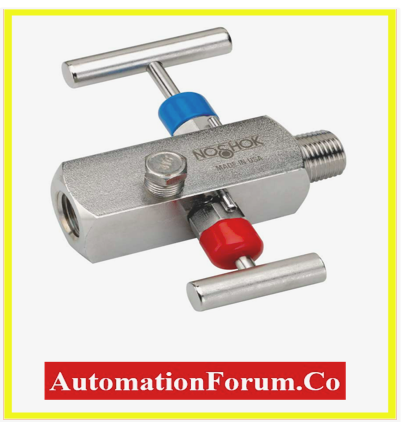
- Double block and bleed valves are primarily used to shut down the upstream process and drain the system’s fluid or pressure. DBB-style valves are appropriate for isolation, calibration, and venting.
- A double Block and the Bleed valve is a small valve system that provides safer isolation in hazardous areas than a single valve. This smaller valve system or single valve unit reduces installation area, eliminates the need for additional piping, and reduces weight in critical areas. It conserves space, time, and money.
- When closed, a double bleed and block valve is a single valve unit that consists of two seating surfaces that provide a seal against pressure from both ends of the valve.
Gauge Root Valve
A gauge Root Valve is a multi-port isolation valve having a single inlet and three outlets.

It is commonly referred to as a “root valve,” and its multiple outlet connections serve a variety of functions. Sometimes only two of the ports are plugged in, with the instrument or gauge connected to the remaining ports.
Frequently asked questions
What are the various types of isolating valves?
Stop or isolation valves come in a variety of shapes and sizes, including gate, globe, ball, butterfly, play, and diaphragm valves.
Where is isolation valves required?
Process isolation or battery limit valves are typically located at the facility’s or operating unit’s perimeter. They typically stop the flow of flammable or hazardous materials into the facility and should be easily accessible in the event of a major emergency.
What are the three most common types of valves?
The three most common types of valves
- Self-Actuated
- Linear
- Rotary
What are the advantages of an Isolation Valve?
- Optimal Leak Tightness.
- Increased Operating Ratio.
- Extended Valve Life.
- Reduced Valve Maintenance.
- Improved Corrosion Resistance.
- Viscous Media Compatibility.
- Increased Reliability.





